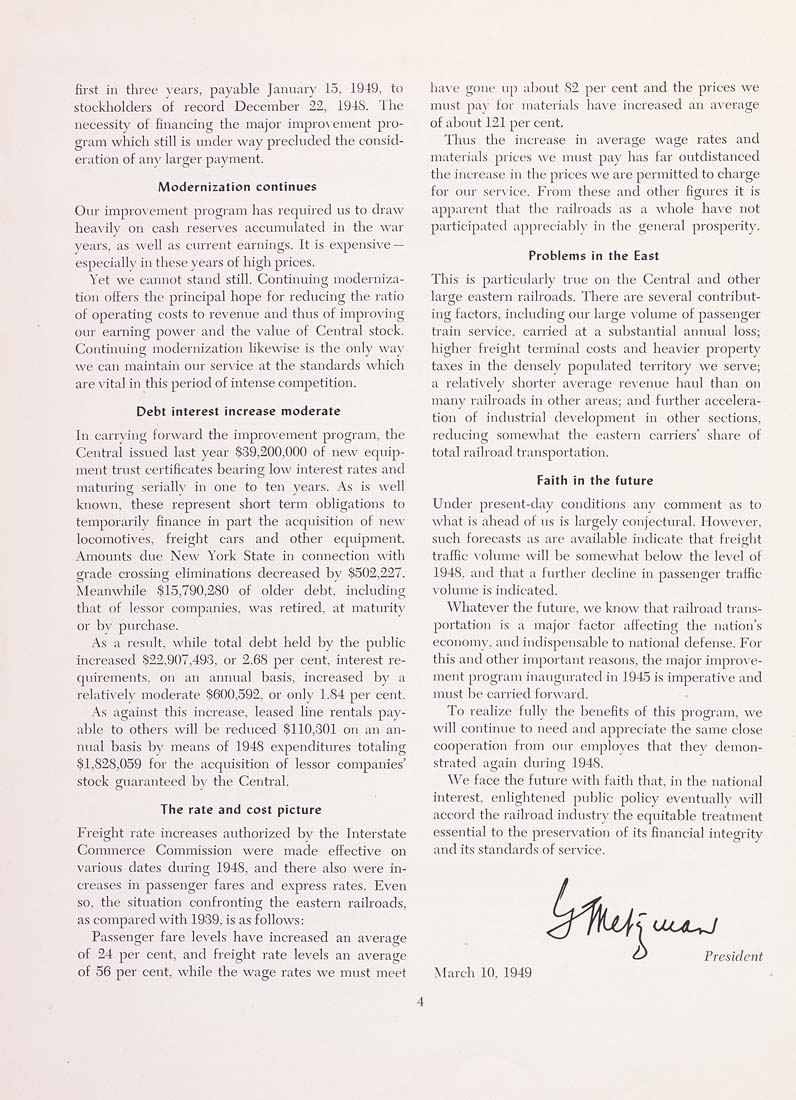first in three years, payable January 15, 1949, to
stockholders of record December 22, 1948. The
necessity of financing the major impro\ ement pro¬
gram which still is under way precluded the consid¬
eration of any larger payment.
Modernization continues
Our improvement program has required us to draw
heavily on cash reserves accumulated in the war
years, as well as current earnings. It is expensive —
especially in these years of high prices.
Yet we cannot stand still. Continuing moderniza¬
tion ofEers the principal hope for reducing the ratio
of operating costs to revenue and thus of improving
our earning power and the value of Central stock.
Continuing modernization likewise is the only way
we can maintain our service at the standards which
are vital in this period of intense competition.
Debt interest increase moderate
In carrying forward the improvement program, the
Central issued last year $39,200,000 of new equip¬
ment trust certificates bearing low interest rates and
maturing serially in one to ten years. As is well
known, these represent short term obligations to
temporarily finance in part the acquisition of ]iew
locomotives, freight cars and other equipment,
Amounts due New York State in connection with
grade crossing eliminations decreased by $502,227.
Meanwhile $15,790,280 of older debt, including
that of lessor companies, was retired, at matin-ity
or by purchase.
As a result, while total debt held by the public
increased $22,907,493, or 2.68 per cent, interest re¬
quirements, on an annual basis, increased by a
relatively moderate $600,592, or only 1.84 per cent.
As against this increase, leased line rentals pay¬
able to others will be reduced $110,301 on an an¬
nual basis by means of 1948 expenditin-es totaling
$1,828,059 for the acquisition of lessor companies'
stock guaranteed by the Central.
The rate and cost picture
Freight I'atc increases authorized hv the Interstate
Commerce Commission were made effective on
various dates during 1948, and there also were in¬
creases in passenger fares and express rates, Even
so, the situation confronting the eastern railroads,
as compared with 1939, is as follows:
Passenger fare levels have increased an average
of 24 per cent, and freight rate levels an average
of 56 per cent, while the wage rates we must meet
have gone up about 82 per cent and the prices we
must pa\" for materials have increased an average
of about 121 per cent.
Thus the increase in average wage rates and
materials prices we must pay has far outdistanced
the increase in the prices we are permitted to charge
for our service. From these and other figures it is
apparent that the railroads as a whole have not
participated app]cciabl\' in (he genei'al prosperity.
Problems in the East
This is particularly true on the Central and other
large eastern railroads, lliere are several contribut¬
ing factors, including our large volume of passenger
train service, carried at a siibstantial annual loss;
higher freight terminal costs and heavier property
taxes in the densely populated territory we serve;
a relatively shorter average re\'enue haiil than on
many railroads in other areas; and further accelera¬
tion of industrial development in other sections,
reducing somewhat the eastern carriers' share of
total raib'oad transportation.
Faith in the future
Under present-day conditions any comment as to
what is ahead of us is largely conjectural. However,
such forecasts as are available indicate that freight
traffic volume will be somewhat below the level of
1948, and that a further decline in passenger traffic
volume is indicated.
Whatever the future, we know that railroad trans¬
portation is a major factor affecting the nation's
economy, and indispensable to national defense. For
this and other important reasons, the major improve¬
ment program inaugurated in 1945 is imperative and
must be carried forward.
To reahze fully the benefits of this progi-am, we
will continue to need and appi-eciate the same close
cooperation from our employes that they demon¬
strated again during 1948.
We face the future with faith tliat, in the national
intc]-est, enlightened public poHcy eventually will
accord the railroad industry the equitable treatment
essential to the preservation of its financial integrity
and its stan<lards of service.
c) President
March 10, 1949
|








